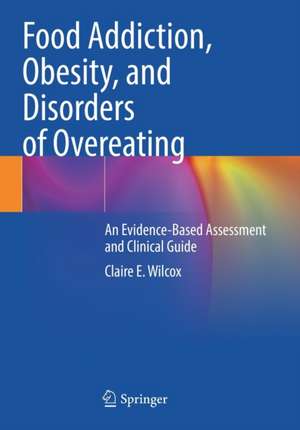Food Addiction, Obesity, and Disorders of Overeating: An Evidence-Based Assessment and Clinical Guide
Autor Claire E. Wilcoxen Limba Engleză Paperback – 2 oct 2022
Food Addiction, Obesity and Disorders of Overeating: An Evidence-Based Assessment and Clinical Guide is suited for both medical and mental health practitioners, including physicians in primary care or psychiatry, nurses, psychologists, social workers, medical students and medical residents. It could also be utilized by researchers in obesity and ED fields, stimulating ideas for future research and study design.
| Toate formatele și edițiile | Preț | Express |
|---|---|---|
| Paperback (1) | 746.25 lei 22-36 zile | +22.97 lei 5-11 zile |
| Springer International Publishing – 2 oct 2022 | 746.25 lei 22-36 zile | +22.97 lei 5-11 zile |
| Hardback (1) | 914.12 lei 38-44 zile | |
| Springer International Publishing – oct 2021 | 914.12 lei 38-44 zile |
Preț: 746.25 lei
Preț vechi: 785.53 lei
-5% Nou
Puncte Express: 1119
Preț estimativ în valută:
142.79€ • 149.49$ • 118.15£
142.79€ • 149.49$ • 118.15£
Carte disponibilă
Livrare economică 17-31 martie
Livrare express 28 februarie-06 martie pentru 32.96 lei
Preluare comenzi: 021 569.72.76
Specificații
ISBN-13: 9783030830809
ISBN-10: 3030830802
Pagini: 226
Ilustrații: XV, 226 p. 7 illus., 6 illus. in color.
Dimensiuni: 178 x 254 x 17 mm
Greutate: 0.43 kg
Ediția:1st ed. 2021
Editura: Springer International Publishing
Colecția Springer
Locul publicării:Cham, Switzerland
ISBN-10: 3030830802
Pagini: 226
Ilustrații: XV, 226 p. 7 illus., 6 illus. in color.
Dimensiuni: 178 x 254 x 17 mm
Greutate: 0.43 kg
Ediția:1st ed. 2021
Editura: Springer International Publishing
Colecția Springer
Locul publicării:Cham, Switzerland
Cuprins
Part I: Standard Approaches to Clinical Assessment and Treatment of Obesity and Binge Eating Disorder (BED).- 1. Determinants of Body Weight: Metabolism and the Homeostatic System.- 2. Obesity.- 3. Binge-Related Eating Disorders (Binge Eating Disorder and Bulimia Nervosa).- Part II: Can The Food Addiction Concept Improve Treatment?.- 4. Problems with Current Approaches to Treating Disorders of Overeating.- 5. The Food Addiction Concept: History, Controversy, Potential Pitfalls and Promises.- Part III: Clinical Evidence for Food Addiction.- 6. Clinical Evidence for the Validity of Food Addiction.- Part IV: Basic Biology of Food Addiction, and Its Overlap with Substance Use Disorders.- 7. Neurobiology and Cognitive Neuroscience of Substance Use Disorders.- 8. Neurobiology and Cognitive Neuroscience of Hedonic Eating.- 9. Additional Biological Mechanisms of Hedonic Eating.- 10. Treatment-Related Evidence that Food Addiction is a Valid Construct.- 11. Highly Palatable Foods Are Addictive.- Part V: Assessment and Treatment of Food Addiction.- 12. Evaluation of Food Addiction: Importance, Epidemiology, Diagnosis, and Assessment.- 13. How to Treat Food Addiction from a Nutritional Perspective: Consideration of Diet and Abstinence.- 14. Clinical Applications of the Food Addiction Concept.- Part VI: Research Possibilities.- 15. Emerging Treatments and Areas for Future Research.
Notă biografică
Claire E. Wilcox MD
Mind Research Network
Albuquerque, NM
USA
USA
Textul de pe ultima copertă
This book is written for providers of broad training backgrounds, and aims to help those who care for people with EDs, overweight and obesity provide evidence-based care. The goal of the book is to provide these providers with a straightforward resource summarizing the current standard of care. However, it goes further by also introducing the concept of food addiction (FA) as a model to understand some forms of overeating. This book discusses the pros and cons of embracing FA and reviews the evidence for and against the validity and utility of FA. By doing so, the chapters convey a “middle ground” approach to help people with obesity, BED, and bulimia nervosa plus FA symptomatology who also want to lose weight. The text discusses FA by reviewing several of the main ongoing controversies associated with the construct. It reviews both the clinical and neuroscientific evidence that some individuals’ eating behavior mirrors that seen in substance use disorders (SUD), such as how their relationship with food appears to be “addictive”. Chapters also discuss how many of the mechanisms known to underlie SUDs appear to drive overeating in animal models and humans. Finally, the text argues that the similarities between the brain mechanisms of addictive disorders and overeating behavior has the potential to open up new avenues for current treatment and treatment development.
Food Addiction, Obesity and Disorders of Overeating: An Evidence-Based Assessment and Clinical Guide is suited for both medical and mental health practitioners, including physicians in primary care or psychiatry, nurses, psychologists, social workers, medical students and medical residents. It could also be utilized by researchers in obesity and ED fields, stimulating ideas for future research and study design.
Food Addiction, Obesity and Disorders of Overeating: An Evidence-Based Assessment and Clinical Guide is suited for both medical and mental health practitioners, including physicians in primary care or psychiatry, nurses, psychologists, social workers, medical students and medical residents. It could also be utilized by researchers in obesity and ED fields, stimulating ideas for future research and study design.
Caracteristici
Authored by an expert in the field of addiction psychiatry Reviews underlying mechanisms in obesity and disorders of overeating and SUDs Introduces the concept of food addiction as a model to understand some forms of overeating
